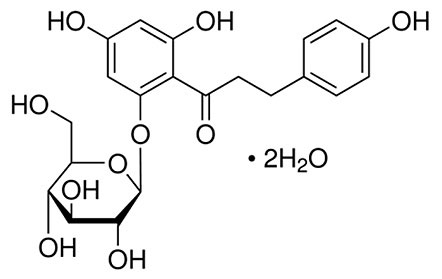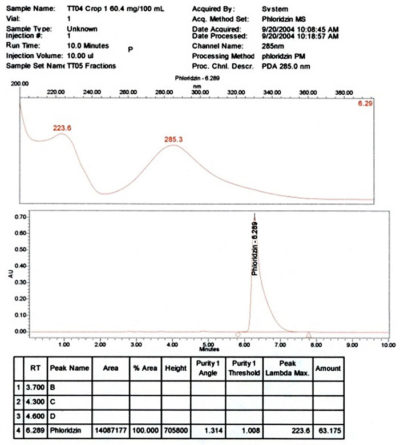A dihydrochalcone, from apple wood (Malus sp.), has been shown to reduce blood glucose levels and may be a natural anti-diabetic molecule
- Catalog No: APH-20041
- CAS Number: 7061-54-3
- Chemical Formula: C21H24O10•2H2O
- Molecular Weight: 472.44
- Purity: > 99% determined by HPLC
- Appearance: White crystalline solid
Source:
Phloridzin, a dihydrochalcone, is found in all parts of the apple tree (Malus sp.) except the mature fruit. It is the predominant phenolic compound in leaves with a dry weight of 18% (Petkovsek et al., 2009).
At Aphios®, Phloridzin is extracted from apple wood using segmentation chromatography.
Biological Activity:
Dietary consumption of Phloridzin has been shown to reduce blood glucose levels (Masumoto et al., 2009). Phloridzin is shown to induce experimental glycosuria by blocking the reabsorption of glucose from the kidney (Shapiro, 1946). The anti-diabetic action is through the competitive inhibition of the sodium-dependent blood transporters (SGLT1 and SGLT2) of metabolites such as glucose (Ehrenkranz et al., 2005).
Additionally, Phloridzin activates a cascade of enzymes, including tyrosinase, by blocking the activity of protein kinase C (Shoji et al., 1997). As a result, it is involved in inhibiting the growth of tumor cells (Shoji et al., 1997) and provides increased protection against ultraviolet radiation through the activation of melanogenesis (Jung et al., 2009).
References:
Ehrenkranz J, Lewis N, Kahn C and Roth J. (2005). Phlorizin: a review. Diabetes Metab Res Rev. 21: 31-8.
Jung E, Lee J, Huh S, Lee J, Kim Y, Kim G and Park D. (2009). Phloridzin-induced melanogenesis is mediated by the cAMP signaling pathway. Food Chem Tox. 47: 2436-2440.
Masumoto S, Akimoto Y, Oike H and Kobori M. (2009). Dietary Phloridzin reduces blood glucose levels and reverses Sglt1 expression in the small intestine in Streptozotocin-induced diabetic mice. J Agric Food Chem. 57: 4651-4656.
The Merck Index (2001). Thirteenth Edition. p. 7414.
Petkovsek M, Stampar F and Veberic R. (2009). Seasonal changes in phenolic compounds in the leaves of scab-resistant and susceptible apple cultivars. Can J Plant Sci. 89:745–753.
Shapiro B. (1946). The mechanism of Phloridzin glycosuria. Biochem J. 441: 151-154.
Shoji T, Kobori M, Shinmoto H, Tanabe M and Tsushida T. (1997). Progressive effects of Phloridzin on melanogenesis in B16 mouse melanoma cells. Biosci Biotech Biochem. 61: 1963-1967.

